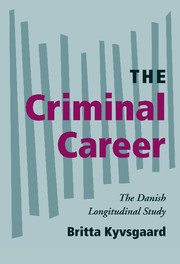Book contents
- Frontmatter
- Contents
- List of Tables
- List of Figures
- Foreword and Acknowledgments
- The Criminal Career
- 1 The Career Concept in Criminological Research
- I Objectives, Methodology, and Sample
- II The Criminal Career
- 7 Prevalence
- 8 Individual Crime Frequencies
- 9 Criminal Onset
- 10 Recidivism and Duration of the Criminal Career
- 11 Desistance from the Criminal Career
- 12 Specialization or Versatility in the Types of Offenses
- 13 Escalation in the Seriousness of Crime
- III Sanctions and Deterrence
- IV Discussion of Results
- References
- Index
12 - Specialization or Versatility in the Types of Offenses
from II - The Criminal Career
Published online by Cambridge University Press: 09 July 2009
- Frontmatter
- Contents
- List of Tables
- List of Figures
- Foreword and Acknowledgments
- The Criminal Career
- 1 The Career Concept in Criminological Research
- I Objectives, Methodology, and Sample
- II The Criminal Career
- 7 Prevalence
- 8 Individual Crime Frequencies
- 9 Criminal Onset
- 10 Recidivism and Duration of the Criminal Career
- 11 Desistance from the Criminal Career
- 12 Specialization or Versatility in the Types of Offenses
- 13 Escalation in the Seriousness of Crime
- III Sanctions and Deterrence
- IV Discussion of Results
- References
- Index
Summary
specialization refers to the tendency to commit the same type of crime. The expectation that the development of the criminal career involves specialization is nurtured by criminological research, the mass media, and everyday language.
Much popular crime literature concerns offenders who commit only a single murder, for example, in the novels of Simenon and Agatha Christie. In these stories, the offender is typically unknown to the police beforehand, as there is no long criminal career before the murder to indicate a general tendency toward criminality. Some crime novels, such as Maurice Leblanc's stories about Arsene Lupin, portray the offender as a specialist, an individual who commits the same offense several times in the same way (Arnold and Schmidt, 1978).
The concept of the specialized offender presumably also arises from some of the more notorious “true crime” cases, including those of Jack the Ripper, Henri Désiré Ladru, and John Reginald Christie, who all committed exactly the same crime in the same way multiple times.
Belief in the existence of specialized offenders is further reflected in everyday language, especially in the crime-related news of the mass media. Linguistic simplifications alone do not give rise to expressions such as “the burglar,” “the sex offender,” and “the violent offender.” The identification of an individual through an offense indicates both social rejection and an expectation that it is neither the first nor will it be the last time the individual has committed a particular type of crime.
- Type
- Chapter
- Information
- The Criminal CareerThe Danish Longitudinal Study, pp. 147 - 168Publisher: Cambridge University PressPrint publication year: 2002



